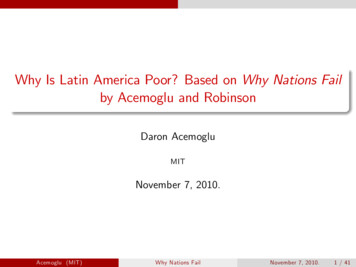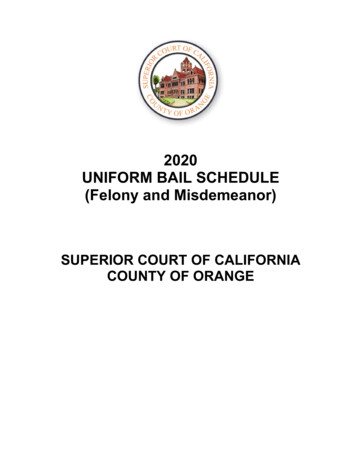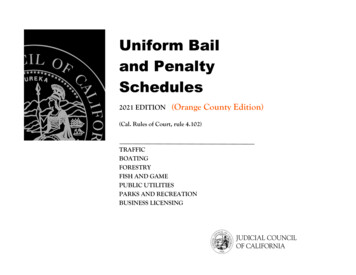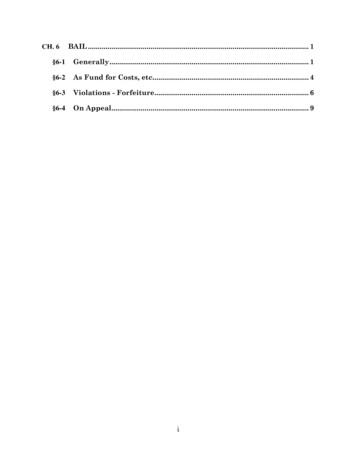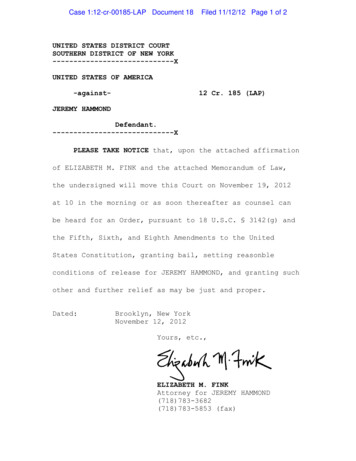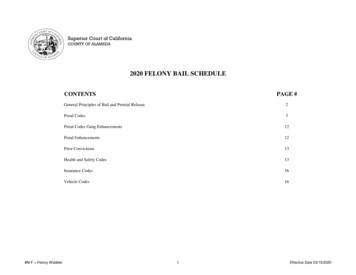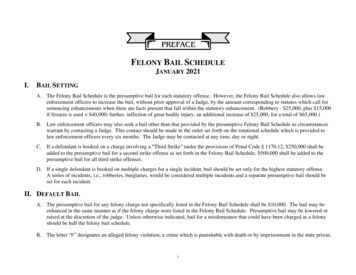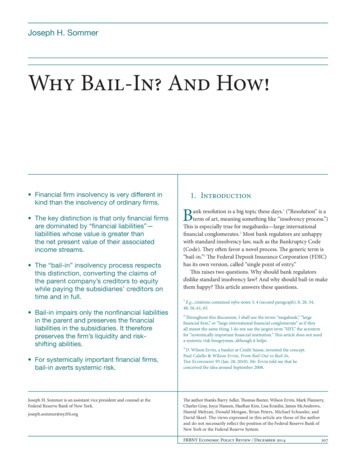
Transcription
Joseph H. SommerWhy Bail-In? And How! Financial firm insolvency is very different inkind than the insolvency of ordinary firms. The key distinction is that only financial firmsare dominated by “financial liabilities”—liabilities whose value is greater thanthe net present value of their associatedincome streams. The “bail-in” insolvency process respectsthis distinction, converting the claims ofthe parent company’s creditors to equitywhile paying the subsidiaries’ creditors ontime and in full. Bail-in impairs only the nonfinancial liabilitiesin the parent and preserves the financialliabilities in the subsidiaries. It thereforepreserves the firm’s liquidity and riskshifting abilities. For systemically important financial firms,bail-in averts systemic risk.Joseph H. Sommer is an assistant vice president and counsel at theFederal Reserve Bank of New York.joseph.sommer@ny.frb.org1. IntroductionBank resolution is a big topic these days.1 (“Resolution” is aterm of art, meaning something like “insolvency process.”)This is especially true for megabanks—large internationalfinancial conglomerates.2 Most bank regulators are unhappywith standard insolvency law, such as the Bankruptcy Code(Code). They often favor a novel process. The generic term is“bail-in.”3 The Federal Deposit Insurance Corporation (FDIC)has its own version, called “single point of entry.”This raises two questions. Why should bank regulatorsdislike standard insolvency law? And why should bail-in makethem happy? This article answers these questions.1E.g., citations contained infra notes 3, 4 (second paragraph), 8, 28, 34,48, 56, 61, 65.2Throughout this discussion, I shall use the terms “megabank,” “largefinancial firm,” or “large international financial conglomerate” as if theyall meant the same thing. I do not use the jargon term “SIFI,” the acronymfor “systemically important financial institution.” This article does not needa systemic risk boogeyman, although it helps.3D. Wilson Ervin, a banker at Credit Suisse, invented the concept.Paul Calello & Wilson Ervin, From Bail-Out to Bail-In,The Economist 95 (Jan. 28, 2010). Mr. Ervin told me that heconceived the idea around September 2008.The author thanks Barry Adler, Thomas Baxter, Wilson Ervin, Mark Flannery,Charles Gray, Joyce Hansen, HaeRan Kim, Lisa Kraidin, James McAndrews,Hamid Mehran, Donald Morgan, Brian Peters, Michael Schussler, andDavid Skeel. The views expressed in this article are those of the authorand do not necessarily reflect the position of the Federal Reserve Bank ofNew York or the Federal Reserve System.FRBNY Economic Policy Review / December 2014207
My answers are not quick ones. The theory for a quickanswer is not there. Few bankruptcy scholars or practitionersknow about financial firm insolvency. Unlike bankruptcy,the secondary legal literature on financial firm insolvency issparse.4 Not everybody has read it, and besides, I have a fewnotions of my own.The first section of this article therefore discussesmegabank insolvency. Ordinary bankruptcy law makes manytacit assumptions as to what a generic firm should be. Manyof these assumptions are invalid—or even inverted—forfinancial firms. The second section defines and discussesbail-in. The third section defines, discusses, and dismisses thealternatives to bail-in.With this teaser, let us get started.4I know of one excellent, if ancient, monograph. Hirsch Braver,Liquidation of Financial Institutions (1936). It remains useful for afew technical issues; cf. Office of the Comptroller of the Currency,Instructions to National Bank Receivers (1932). There are threeuseful modern monographs: David A. Skeel, The New FinancialDeal: Understanding the Dodd-Frank Act and Its (Unintended)Consequences (2011); Bankruptcy Not Bailout: A SpecialChapter 14 (Kenneth E. Scott & John B. Taylor, eds., 2012) (“HooverInstitution”); Eva Hüpkes, The Legal Aspects of Bank Insolvency:A Comparative Analysis of Western Europe, the United Statesand Canada (Kluwer 2000). The law review literature is sparse betweenthe Depression and the 2008 crisis. Robert R. Bliss & George G. Kaufman,U.S. Corporate and Bank Insolvency Regimes: A Comparison and Evaluation,2 Va. L. & Bus. Rev. 143 (2007); Thomas C. Baxter, Joyce M. Hansen& Joseph H. Sommer, Two Cheers for Territoriality, 78 Am. Bankr.L.J. 57 (2004); David A. Skeel, The Law and Finance of Bank andInsurance Insolvency, 76 Tex. L. Rev. 723 (1998); Peter B. Swire, BankInsolvency Law Now that It Matters Again, 42 Duke L.J. 469 (1992);William R. Buck, Jr., Comment, Bank Insolvency and DepositorSetoff, 51 U. Chi. L. Rev. 188 (1984). See also, e.g., Group of Thirty,International Insolvencies in the Financial Sector 84 (1998);G-10 Contact Group on the Legal and Institutional Underpinnings of theInternational Financial System: Insolvency Arrangements and ContractEnforceability (September 2002) at http://www.bis.org/publ/gten06.htm.Recently, the topic has become more trendy: e.g., Skeel, supra; HooverInstitute, supra; Douglas G. Baird & Edward R. Morrison, Dodd-Frank forBankruptcy Lawyers, 19 Am. Bankr. Inst. L. Rev. 287 (2011); David A. Skeel& Thomas H. Jackson, Transaction Consistency and the New Finance inBankruptcy, 112 Colum. L. Rev. 152 (2012); Peter Conti-Brown, ElectiveShareholder Liability, 64 Stan. L. Rev. 409 (2012); Randall D. Guynn,Are Bailouts Inevitable?, 29 Yale J. Reg. 121 (2012); Adam J. Levitin, InDefense of Bailouts, 99 Geo L.J. 435 (2011); John R. Bovenzi, RandallD. Guynn & Thomas H. Jackson, Too Big to Fail: The Path to aSolution (Bipartisan Policy Center 2013); Thomas F. Huertas, Safe to Fail,28 Butterworth’s J. of Int’l Banking & Fin. L. 407 (2013); Paul Tucker,Resolution and Future of Finance (May 20, 2013) (available at http://www.bis.org/review/r130606a.pdf?frames 0(last visited June 12, 2013); High-Level Expert Group onReforming the Structure of the E.U. Banking Sector (available athttp://ec.europa.eu/internal market/bank/docs/high-level expert group/report en.pdf) (last visited September 26, 2013).208Why Bail-In? And How!2. Why Megabanks Are DifferentMegabanks are more than big banks. They are more complex;they are more interlocked; they are more global. They alsohave a peculiar corporate structure and—most importantly—peculiar liabilities. They are atypical firms. As we shall see,they need atypical insolvency law.This section does four things. It starts with the balance sheetof megabanks. All financial firms have peculiar balance sheets.Megabanks are more peculiar yet. Megabanks are highlyleveraged. Their liabilities are generally financial products,often very liquid. Finally, megabanks are conglomerates, withclose connections among component entities.After these balance-sheet concerns, we then look at thebusiness of megabanking. Several traits stand out: personnel,interconnections, and a global reach. These all affectmegabank insolvency.We then look at the nature of bank supervision—including megabank supervision. Supervision is tightly tiedto insolvency, much as corporate finance is tied to corporateinsolvency. The incentives of local supervisors are a powerfulforce in cross-border megabank insolvency.Add all these together, and we have our conclusion:Megabank insolvency is different from that ofother businesses.2.1 The Peculiar Balance Sheet of MegabanksWe begin by looking at the balance sheet of large financialfirms. A “financial firm,” for our purposes, has a high degreeof leverage. It also has something I call “financial liabilities.”Megabanks also have a conglomerate structure.We begin with the two traits that megabanks share withother financial firms: leverage and financial liabilities.LeverageAlmost all financial firms are highly levered. Debt-equityratios of 1:1 are typical for ordinary firms: the widgetmaker of the textbook. Financial firms’ debt-equity ratiosare much higher: about 15:1-30:1 for banks and securitiesfirms,5 and somewhat less for insurers. This leverage hassome implications.5Sebnem Kalemli-Ozcan, Bent Sorensen & Sevcan Yesiltas, Leverage AcrossFirms, Banks, and Countries, 88 J. Int’l Econ. 284 (2012).
First, financial firms maintain good credit despite theirhigh leverage. Before the recent crisis, banks typically gotratings around A- to AA.6 This need do no violence to thebasic tenets of corporate finance. Financial firm assets aretypically much safer (i.e., lower in variance) than the assets ofgeneral business firms. They must be. The classical bank assetis somebody else’s debt. Debt is paid before profit. A firm thatspecializes in holding debt will have less risk than firms thatmust pay the debt.However, megabanks hold many assets other than simpledebt. Some of these other assets are risky indeed. To reducethe variance of these assets, megabanks use diversificationand hedging schemes. Diversification and imperfect hedging,of course, rely on historical behavior. Beyond a few standarddeviations, history is bunk—so-called “tail risk.” Megabanksare inherently sensitive to tail risk in their models, moreso than less sophisticated firms. We have seen this severaltimes in the past few decades: Askin Capital, Long-TermCapital Management, and AIG come to mind. None of thesefirms had bank charters, but our definition of “megabank”needs no charter.Second, high leverage is hard to measure. In a highlylevered firm, the value of assets is close to the value ofliabilities. A small error in measurement can lead to a largeerror in reported leverage. Measurement is harder in theinsurance industry, where the (contingent) liabilities of claimsare probably more difficult to measure than asset values. Butit is bad enough in banking, and amplified by the greaterleverage in the banking industry. This is especially true formegabanks with substantial contingent liabilities in the formof derivatives contracts. Similarly, a small change in thevariance of bank assets can lead to a large change in bank risk.This has some unpleasant implications for governance. AsJensen and Meckling have told us, overleveraged firms maygamble with their creditors’ money.7 But the leverage and riskof banks is difficult to measure. A small increase in either ishard to verify, and banks traditionally had weak creditors,anyway. This is both a good argument for capital regulation(smaller risk substitutions are more effective in leveragedfirms), and for supervision (a creditors’ agent argumentindependent of deposit insurance).Third, leverage is hard to define, even if it is measurable.The notion of leverage distinguishes between some liabilitiescalled “capital” and other liabilities. This distinction maystill exist in corporate law, but corporate finance theoryviews it as mere superstition.8 There are only classes of risk,with different classes of control appropriate to the risk class.Nonetheless, financial regulators think that it is important tosharply distinguish some kinds of liabilities from others.They do not draw the line at equity. They will also considersome kinds of subordinated debt and preferred stock tobe capital. Other kinds of debt—even long-term debt—donot so qualify.The regulators are right, and the theory is wrong. Not allliabilities are created equal, like beads on a linear string ofrisk. As we shall see, some liabilities—financial liabilities—are indeed different in kind.Financial LiabilitiesFinancial liabilities are a key concept in this article—the keyconcept of this article. Since induction trumps deduction,a list should precede my definition. Financial liabilities arethose that only financial firms are in the business of incurring.They include things like bank deposits, derivative contracts,insurance policies, and repos. Corporate debt or trade creditsare not financial liabilities. This is also true of the corporatedebt or trade credit of financial firms.With our intuition set, we should now define the term.We need a definition that makes a difference in insolvency.Two such definitions come to mind.Perhaps the best definition of a financial liability is onewhose value is impaired by the insolvency process. Yes,insolvency does nothing if it does not affect liabilities. ButI mean this in a certain special sense, one evoked by an oldbankruptcy lawyers’ joke: “not only does the food taste awful,but the portions are too small.” This joke is funny becauseit is true. The portions must be too small: insolvency mustimpair liabilities. Somebody will not get what they bargainedfor. And the food tastes awful: bankruptcy destroys value. Butvalue destruction is not an inherent trait. An ideal insolvencyprocess can impair liabilities quickly, smoothly, and with nocollateral damage. But the Bankruptcy Code, although prettygood, is not an ideal process.We usually think in terms of destroyed asset value—deadweight losses, such as administrative costs, lost goingconcern value, and so on. Value is destroyed on the asset side,and modern insolvency law mitigates this destruction. But6Frank Packer & Nikola Tarashev, Rating Methodologies for Banks, BISQuarterly Review 39, 41, 49 (June 2011) (citing Fitch and Moody’s ratings).A notch or two of these ratings consisted of government support, but they arestill investment grade. Id. at 50.7Michael Jensen & William Meckling, Theory of the Firm: ManagerialBehavior, Agency Costs, and Capital Structure, 3 J. Fin. Econ. 305 (1976).8To be fair, some corporate finance theorists are beginning to see the wisdomto this superstition, at least where systemic risk is concerned. Oliver Hart& Luigi Zingales, A New Capital Regulation for Large Financial Institutions,13 Am. L. & Econ. Rev. 453, 455-54 (2011). But as we shall see, the issue isa more general one than systemic risk.FRBNY Economic Policy Review / December 2014209
some special liabilities—financial liabilities—may also losevalue in the insolvency process, beyond any value measuredby the net present value of the claim. They, too, suffer adeadweight loss.Financial liabilities are more than claims to a future streamof income. Yes, they are that, but they are something else,too. Some of them, such as bank deposits, are also sourcesof liquidity. Others—derivatives or insurance policies—shiftrisk. These liabilities are also credit instruments. But unlike,say, corporate bonds, their credit nature is incidental to—but inherent in—their liquidity or risk-shifting functions.Liquidity and risk shifting are valuable in themselves—valuable beyond the face value of the financial liability. This isnot a conjecture. It is a revealed preference. Insurance policiescost more than their net present value. Liquid debts pay lesswell than illiquid ones.This has potent implications in insolvency. If financialliabilities have value that goes beyond their face value,the extra cost of impairing them in insolvency is itself adeadweight loss, exceeding the cost of impairing otherliabilities. This cost includes impaired liquidity or riskshifting, as well as an impaired payment stream. This costis substantial, and it can be enormous if it takes the form ofsystemic risk.9Good insolvency law would protect these liabilities:preserve their liquidity or risk-shifting functions. This wouldbe at the cost of other liabilities: the familiar ModiglianiMiller seesaw. However, this seesaw has no fixed pivot:priority creates value. The other liabilities are mere streamsof income, with no other function. The cost of impairingthem is less than the cost of impairing financial liabilities.This leads to the central policy implication of this article:Financial liabilities deserve priority treatment in insolvencylaw. Such priority exists today, ordinal and often temporal.Financial liabilities are often paid first in line and often firstin time, before any payments to other creditors. We returnto this point below, after a detour through a few of thesefinancial liabilities.A checking account is a financial liability. People holdthese accounts because they are liquid. A delayed insolvencydistribution is an illiquid distribution. An illiquid distributionis costly. For an individual, these costs may include bad creditreports, eviction, or delayed medical care. For a firm, thesecosts may include strained relations with creditors, or evenits own insolvency. For a megabank, the costs can extend tochain-reaction illiquidity and insolvency: systemic risk. In atypical bank insolvency, checking accounts are typically paidin full with no delay.9See infra text accompanying note 23.210Why Bail-In? And How!Bank deposits are not the only financial liability. Insurancepolicies are another. Consider a term life policy as anexample, with an insolvent insurer. To healthy policyholders,the policy is worth little, because it is easy to replace. Butconsider a person who purchased the policy at a low costwhen healthy, has subsequently developed cancer, andhas a right to renew. What does it mean for an insolvencydistribution to treat all policyholders equally? A quick pro ratadistribution would be a disaster for the sick policyholder,who will not be able to replace the policy on the market. Afuture claims estimation process could be a nightmare oflitigation. Insurance insolvencies, therefore, are often theopposite of bank insolvencies: very slow, so that all claims maycome to fruition. Policyholders are first in line, even if theline moves slowly.Brokerage accounts are financial liabilities, much like bankdeposits. We usually think of them as direct property rightsof the customer, with the broker acting as a kind of bailee.But the property law of securities, contained in UniformCommercial Code (UCC) Article 8, shows that they aregenerally relationships between the broker and customer,rather than a direct property right of the customer against theissuer.10 Again, the liquidity of these securities is important.Issuers structure debt as a security rather than a direct loanto enhance its liquidity, either in the distribution process orthe secondary market. The Security Investors Protection Act(SIPA) insolvency, as well as Subchapter III of Chapter 7 of theCode, further enhance this liquidity. They rapidly transfer thecustomer securities of insolvent brokers to another party thatcan comply with customer orders.The protected contracts of the Federal Deposit InsuranceAct (FDI Act) and Bankruptcy Code can also be financialliabilities. (These liabilities are characteristic of megabanks.)Derivative contracts are intended to shift risk. Insolvencyimpairs this function. Many securities contracts have a similarfunction. Many of these transactions hedge portfolios ofmarket risk. Repo creates liquidity.In other words, financial contracts are contracts in whichcredit risk is incidental. The creditor in such contracts is notprimarily an investor: paying money now to get more later.Instead, it wants liquidity, or insurance, or other kind of riskshifting. It is the creditor that is different, not the debtor. To afinancial firm, the proceeds of a financial liability are a formof credit, used like any other credit. This suggests a seconddefinition of a financial liability: a product of a firm, sold to10Some of the more important pieces of secondary literature:James Steven Rogers, Policy Perspectives on Revised U.C.C. Article8, 43 U.C.L.A. L. Rev. 1432 (1996); Kenneth C. Kettering, RepledgeDeconstructed, 61 U. Pitt. L. Rev. 45 (1999); Steven L. Schwarcz,Intermediary Risk in a Global Economy, 50 Duke L.J. 1541 (2001).
customers. This definition pretty much overlaps with the first.It is less analytically pleasing, because it does odd things likeexclude interdealer derivatives contracts. But it explains much,works well, and is easy on the intuition.This notion of a financial liability as a product hasimplications for insolvency law, apart from priorities.Insolvency law assumes that firms often need a breathingspell from their creditors, so that they can pick themselves up,continue operating, and start reorganizing. It therefore placesall claims in a collective procedure and places a moratoriumon efforts to collect ass
Nov 12, 2013 · to insolvency, much as corporate finance is tied to corporate insolvency. The incentives of local supervisors are a powerful force in cross-border megabank insolvency. Add all these together, and we have our conclusion: Megabank insolvency is different from that of othe


